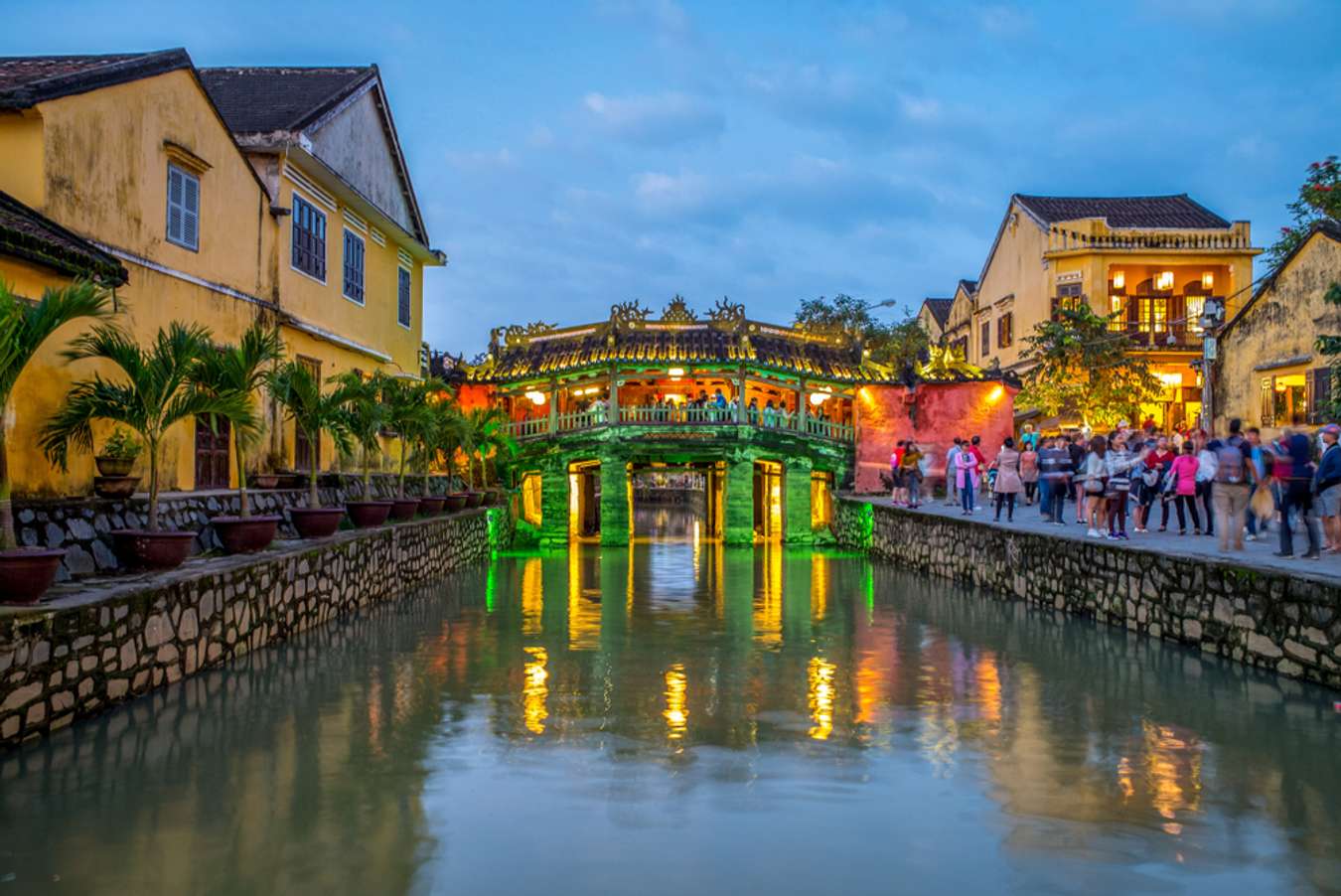Your Essential Guide to Hoi An City Centre: The Ancient Town
Welcome to Hoi An, a town where the past isn’t just remembered; it’s vibrantly alive in every saffron-yellow wall, every glowing silk lantern, and every cobblestone street. The heart of this enchanting destination is its city centre, a beautifully preserved UNESCO World Heritage site known simply as the Ancient Town. Stepping into this area feels like stepping back in time, leaving the buzz of the modern world behind for a place of timeless, captivating beauty. This guide is your personal key to unlocking the very best of Hoi An’s city centre, from its most iconic sights to its most delicious, well-kept secrets. Let’s explore together.

1. Hoi An In-a-Nutshell: Quick Planner
In a hurry? Or just too excited to wait? I get it. Here’s everything you need to know at a glance to get your adventure started.
- The Main Attraction: The Hoi An Ancient Town. This is the historic core you’ve seen in all the pictures. It’s a pedestrian-friendly zone where cars and motorbikes are restricted during peak hours (typically 9:00 AM – 11:00 AM and 3:00 PM – 9:30 PM), making it a joy to explore on foot.
- Entrance Fee: The official entrance fee is 120,000 VND (roughly $5 USD) for international tourists. Don’t think of it as just a fee; it’s a “coupon ticket” that grants you access to the Ancient Town’s charming streets and allows entry to five of over twenty incredible heritage sites, including the old houses, assembly halls, and the famous Japanese Bridge.
- Top 5 Must-Do Experiences:
- Walk the Japanese Covered Bridge: This 17th-century bridge is the undeniable symbol of the city. My pro tip? Go at sunrise to have it almost entirely to yourself.
- Release a Lantern on the Hoai River: Join the magical nightly ritual of releasing paper lanterns for good luck. The sight of hundreds of these little flames drifting on the water is pure poetry.
- Get Custom-Made Clothing: You haven’t truly “done” Hoi An until you’ve experienced its legendary tailor services. Get a perfectly fitted suit, dress, or shirt, often ready in just 24-48 hours.
- Taste Authentic Cao Lầu: Seriously, you can’t leave without trying this. It’s a unique noodle dish that, legend says, can only be made with water from a specific, secret local well.
- Wander the Lantern-Lit Streets: Honestly? The best experience in Hoi An is free. It’s simply getting lost in its beautiful, traffic-free alleyways after the sun goes down and the lanterns begin to glow.
- Best For: Romantic getaways, cultural exploration, foodies, photographers, and history enthusiasts. It’s a place that genuinely offers something for everyone.
Understanding Hoi An’s Magic: A Story, Not Just a Place
Hoi An is so much more than just a pretty face; its undeniable charm is rooted in a deep and utterly fascinating history. This isn’t just a tourist town; it’s a living museum.
From Bustling Port to Living Museum
Picture this: from the 15th to the 19th century, this quiet town was a buzzing international trading port, one of the most important in Southeast Asia. Merchants from China, Japan, Holland, and Portugal sailed here, trading silk, ceramics, and spices. This incredible confluence of cultures is what shaped the town’s unique character. Then, a funny thing happened. The Thu Bon River, the town’s lifeblood, began to silt up, making it inaccessible to large ships. The trade moved to nearby Da Nang, and Hoi An was all but forgotten by the world. It was a blessing in disguise. This economic slumber preserved the town perfectly, leaving us with an untouched time capsule of a bygone era.
The Meaning of “UNESCO World Heritage Site“
In 1999, the world remembered Hoi An. UNESCO designated it a World Heritage Site, calling it an “exceptionally well-preserved example of a South-East Asian trading port.” This prestigious status isn’t just a plaque on a wall; it’s a promise. It protects the unique architecture and cultural heritage of the town, ensuring that its story can be told for generations to come. The small fee from your entrance ticket? It goes directly towards this vital preservation work.
The Architecture: A Fusion of Styles
As you walk the streets, pay attention to the buildings. You’re seeing history written in wood and stone. You’ll notice the traditional Vietnamese “tube houses”—long, narrow buildings with courtyards for light and air. You’ll be wowed by the ornate Chinese assembly halls with their grand, tiled gateways guarded by stone dragons. And you’ll spot the subtle, elegant Japanese design elements, most famously in the iconic Covered Bridge. It’s this harmonious blend of styles, all in one place, that makes Hoi An so visually captivating.
The Core Attractions: What to See in Hoi An Ancient Town (with Interactive Map)
Your entrance ticket is your golden key, giving you access to five of the town’s most remarkable heritage sites. With over twenty to choose from, it can be tough to decide. Here are the absolute must-sees to help you pick.
The Icon: The Japanese Covered Bridge (Chùa Cầu)

This beautiful bridge isn’t just a way to cross a small stream; it’s the heart of Hoi An. Built by the Japanese community in the early 17th century to connect with the Chinese quarter across the water, it’s a masterpiece of design. Inside, you’ll find a small, lovingly maintained temple honoring the northern weather god, Tran Vo Bac De, who is believed to control the weather. Look for the statues of a dog and a monkey guarding either end of the bridge; one story says this is because construction started in the year of the dog and finished in the year of the monkey.
Insider Tip: I can’t stress this enough. Visit between 6:30 AM and 7:30 AM. The soft morning light is perfect for photos, and you’ll share the bridge with only a few locals instead of hundreds of tourists. It’s a completely different, almost spiritual experience. Remember to have one of your five ticket stubs ready for entry!
The Assembly Halls: Gateways to the Past
These magnificent halls were the social, spiritual, and commercial hubs for the different Chinese merchant communities who settled in Hoi An. They are stunning examples of traditional Chinese architecture and artistry.
- Fujian (Hokkien) Assembly Hall: Arguably the most famous and impressive. You can’t miss its incredibly ornate main gate. Step inside to a world of intricate carvings, vibrant statues of deities from Chinese mythology, and giant, coiled incense spirals hanging from the ceiling, filling the air with a sweet, smoky scent.
- Cantonese Assembly Hall: This hall is known for its stunning, life-sized dragon and carp sculptures. The main hall is breathtaking, and the peaceful garden in the back, complete with an elaborate dragon fountain, is the perfect place for a quiet moment of reflection.
The Ancient Houses: A Glimpse into Merchant Life
These homes, preserved for generations by the same families, offer a rare and intimate look into the lives of Hoi An’s wealthy merchants.
- Tan Ky Old House: A designated national heritage monument, this 200-year-old home is a perfect example of Hoi An’s architectural fusion, masterfully blending Vietnamese, Chinese, and Japanese styles under one roof. The family still lives here and will proudly show you the markings on the wall indicating how high the floodwaters have risen over the years.
- Phung Hung Old House: This large, two-story house has been home to the same family for over eight generations! It’s notable for its unique “trap door” system on the second floor, designed to move furniture and goods to safety during the annual floods—a brilliant piece of practical design.
What to look for: As you explore these houses, notice the little details. Look for the “yin-yang” tiles on the roofs, designed to keep the house cool. Admire the beautiful mother-of-pearl inlaid furniture. And appreciate the open courtyards, a clever feature designed to bring light and air into the narrow tube-like houses.
Unforgettable Experiences: The Best Things to Do
Beyond the historic sights, Hoi An is a town that needs to be experienced with all your senses. It’s about doing, not just seeing.
Evening Magic: Lantern Boats and the Night Market
As dusk settles over the town, a whole new kind of magic begins. The Hoai River, a tributary of the Thu Bon, comes alive. Take a gentle 20-minute boat ride, paddled by a local, and release a paper lantern onto the water while making a wish. It’s touristy, yes, but it’s also genuinely beautiful. Afterward, cross the An Hoi Bridge to the Night Market. The atmosphere is electric, buzzing with stalls selling everything from colourful silk lanterns and souvenirs to delicious, sizzling street food.
Cost guide: Don’t just hop on the first boat! A fair price for a 20-minute ride should be around 150,000 – 200,000 VND for a private boat that seats a few people. The key is to smile and always agree on the price *before* you get in.
Become a Maker: Lantern & Craft Workshops
Why buy a souvenir when you can make one? Join a lantern-making class and learn the art of stretching silk over a bamboo frame. It’s a fun, hands-on experience, and you get to take home a truly personal memento of your trip. If lanterns aren’t your thing, other popular workshops include pottery at the nearby Thanh Ha Pottery Village or even traditional wood carving.
Get Fitted: The Truth about Hoi An’s Famous Tailors
Hoi An is world-famous for its tailors, and for good reason. But with hundreds of them, how do you choose? It can be overwhelming. The key is to look for shops with consistently good online reviews, clear pricing, and a wide selection of quality fabric samples. A good tailor will always require 2-3 fittings to get it just right.
How to choose: My best advice? Avoid the rock-bottom cheapest offers; you often get what you pay for in terms of fabric and craftsmanship. A quality custom shirt might start around $25 USD, while a full suit could range from $100 to $300+ depending on the material. Shops like Bebe Tailor and Yaly Couture have built solid reputations over many years for their quality and service.
A Foodie’s Dream: Cooking Classes and Food Tours
The best way to understand a culture is through its food. Learn the secrets of the fresh, vibrant flavors of Vietnamese cuisine by taking a cooking class. Many of the best classes, like the one at Red Bridge Cooking School, include a fascinating trip to the bustling central market to select your fresh ingredients, teaching you about local herbs and produce before you even start cooking.
Explore on Two Wheels: Cycling Through the Alleys and Rice Paddies
Rent a bicycle for a couple of dollars a day. It’s the absolute best way to explore. In the morning, pedal through the quiet back alleys of the Ancient Town. In the afternoon, venture just a few minutes outside the centre to find yourself in a sea of green, tranquil rice paddies, where water buffalo graze peacefully. It’s a beautiful, serene contrast to the lively town centre.
A Culinary Guide: What to Eat and Where to Find It
Prepare your taste buds. Hoi An is a culinary paradise, boasting several unique local dishes you simply won’t find anywhere else in Vietnam.

The Holy Trinity of Hoi An Cuisine:
- Cao Lầu: This is Hoi An in a bowl. It consists of thick, chewy rice noodles (the texture is amazing!), slices of savory barbecued pork, fresh local greens like mint and basil, and crispy croutons, all with just a splash of rich pork broth. The secret is the noodles, which are mixed with lye ash from a specific local tree and made with water from the ancient Ba Le well, giving them their unique color and texture.
- White Rose Dumplings (Bánh Bao Bánh Vạc): These are as beautiful as they are delicious. Delicate, translucent shrimp dumplings are expertly shaped to look like white roses, then steamed and served with a sprinkling of crispy fried shallots and a tangy dipping sauce. They are light, delicate, and utterly addictive.
- Banh Mi Phuong vs. Madam Khanh: You can’t come to Vietnam without eating Banh Mi, and Hoi An is home to a legendary rivalry. Banh Mi Phuong is world-famous (thanks, Anthony Bourdain!) and always has a line, serving up a loaded, delicious sandwich. Just down the street, Madam Khanh, the self-proclaimed “Banh Mi Queen,” offers a slightly different but equally incredible sandwich from her humble home. The only correct answer in this debate? Try both and decide for yourself!
Street Food to Hunt For:
Keep your eyes peeled for street vendors selling local treats. Look for bánh bèo (small, steamed rice cakes topped with dried shrimp and a savory sauce), thịt nướng (grilled pork skewers you wrap in rice paper with fresh herbs), and for dessert, chè bắp (a warm, sweet corn soup).
Café Culture:
Hoi An has a fantastic and rapidly growing café scene. Find a spot in a hidden alley, along the riverfront, or on a rooftop with a view. It’s the perfect way to escape the midday heat and enjoy a traditional Vietnamese iced coffee (cà phê sữa đá) or a creamy, decadent egg coffee (cà phê trứng).
Practical Planning: Your Trip Logistics Solved
A little planning goes a long way. Navigating your trip to Hoi An is easy with these essential tips.
The Hoi An Entrance Ticket Explained:
So, do you *really* need the ticket? Here’s the deal. Officially, the ticket is required to enter the heritage buildings, but not necessarily just to walk the streets, especially at night. However, purchasing one is the right thing to do. The revenue is crucial for the town’s ongoing preservation. Think of it as your contribution to keeping Hoi An magical. You’ll find official ticket booths at all the main entrances to the Ancient Town.
Best Time to Visit:
The dry season, from February to July, is ideal, offering blue skies and pleasant temperatures. If you can, try to time your visit with the Full Moon Lantern Festival. Held on the 14th day of each lunar month, the town switches off its electric lights and goes dark, illuminated only by the soft, ethereal glow of thousands of silk lanterns. It’s an unforgettable experience.
Getting to Hoi An:
The nearest airport is in Da Nang (DAD), which is about a 45-minute drive away. From there, you have a few options.
- Taxi/Ride-hailing: You can easily grab a taxi or book a car through the Grab app.
- Private Car: For a completely seamless and stress-free arrival, many travelers prefer booking a private car in advance. This is where a trusted local service comes in handy. Here at Tuan Travel, we specialize in this route. Our professional driver will meet you right at the airport exit, help with your bags, and take you directly to your hotel in a new, clean, air-conditioned vehicle. Our promise is simple: no unscheduled shopping stops or tourist traps. Just a safe, comfortable, and direct journey so you can start your vacation the moment you land.
- Bus Service: For budget-conscious travelers, a bus is a great option. Tuan Travel also offers reliable bus services between Da Nang and Hoi An, and a cost-saving combined ticket that includes transfer to your hotel.
Getting Around:
The Ancient Town is a joy to explore on foot. For venturing further, renting a bicycle is a cheap and wonderful option. For a more relaxed tour of the main sights, hop on a cyclo (a three-wheeled bicycle taxi) and let a local do the pedaling.
Sample Itineraries:
- The Perfect Day in Hoi An: Spend the morning exploring the old houses and assembly halls. Enjoy a delicious lunch of Cao Lầu. Have an afternoon tailor fitting or relax at a café. Take a sunset boat ride on the river, and finish your evening wandering through the Night Market.
- A Relaxed 3-Day Itinerary: Dedicate Day 1 to the Ancient Town’s attractions. On Day 2, take a morning cooking class and spend the afternoon relaxing at An Bang beach. On Day 3, take a bicycle tour of the countryside or book a day trip to the My Son Sanctuary.
Beyond the Ancient Town: Worthwhile Day Trips
Hoi An is the perfect base for exploring the fascinating surrounding region. There’s so much to see just a short trip away.
- An Bang Beach: Just 3km from the city centre lies this beautiful, laid-back stretch of sand. Rent a sun lounger, sip a fresh coconut, and enjoy the waves. It’s the perfect antidote to a morning of sightseeing.
- Cam Thanh Coconut Village: Prepare for a laugh! Take a thrilling and often hilarious ride in a traditional round “basket boat” through a dense and beautiful forest of water coconut palms. The boatmen and women often put on a show, spinning the boats at incredible speeds.
- My Son Sanctuary: About an hour’s drive from Hoi An, this UNESCO World Heritage site is a must for history buffs. It’s a stunning, atmospheric collection of abandoned Hindu temples from the ancient Champa Kingdom, dating from the 4th to the 13th century. Tucked into a jungle-filled valley, it feels like a scene from an Indiana Jones movie. For a comfortable and informative trip, Tuan Travel offers organized tours and private cars with safe, professional drivers who know the route well, allowing you to relax and enjoy the scenery.
Hoi An Travel FAQ
Got a few more questions? You’re not alone. Here are answers to some of the most common queries.
- Is Hoi An too touristy?Let’s be real: it can be crowded, especially in the evening along the river. But its charm is powerful enough to overcome the crowds. The secret is to wake up early. The town is peaceful and incredibly authentic between 6 AM and 9 AM. Or, just wander a block or two away from the main streets, and you’ll find quiet, empty alleys that feel like they belong only to you.
- How many days do you need in Hoi An?I’d recommend a minimum of two full days to see the main sights without rushing. However, three to four days is the sweet spot. This gives you time to explore at a more relaxed pace, get some clothes made, and take one of the fantastic day trips.
- Is it better to stay in Hoi An or Da Nang?This depends entirely on your travel style. Stay in Hoi An if you’re looking for charm, history, incredible food, and a romantic, pedestrian-friendly atmosphere. Stay in Da Nang if you prefer a modern city feel with big beaches, more nightlife options, and large resorts.
- What should I wear when visiting temples and old houses?Respectful attire is key. When entering religious sites like assembly halls and pagodas, as well as the historic old houses, your shoulders and knees should be covered. It’s a simple sign of respect for the local culture. I recommend carrying a light scarf or shawl with you; it’s an easy way to cover up when needed.
Read more: Hoi An Sunset: The Ultimate Guide To An Unforgettable Evening (2025)


